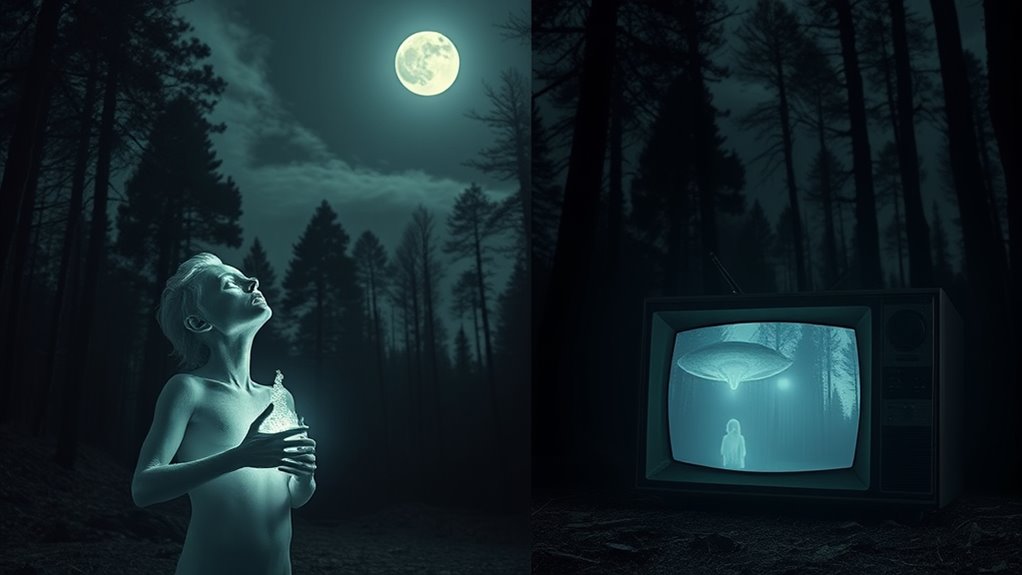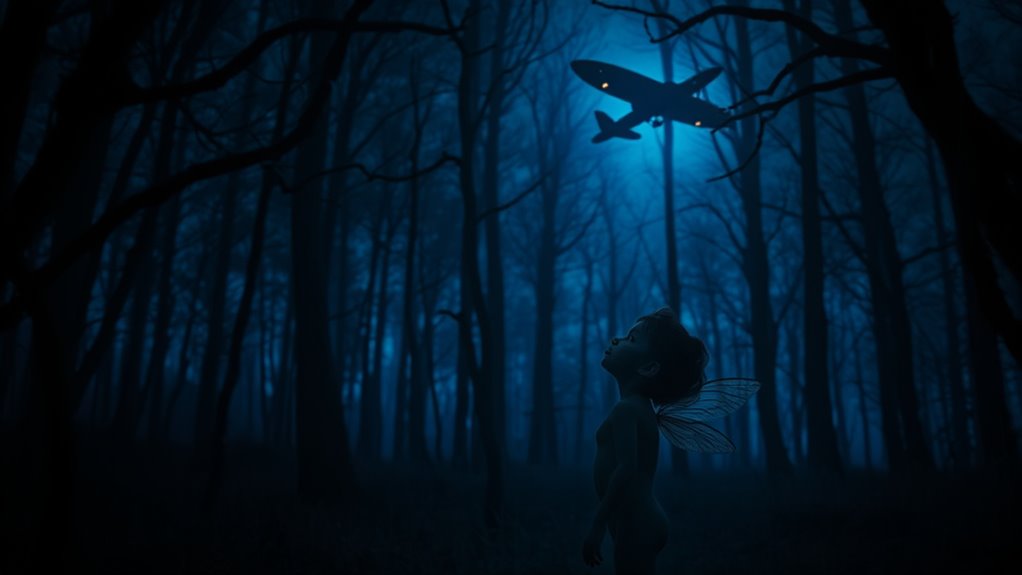Changelings and alien abductions share striking parallels rooted in ancient folklore and modern experiences, reflecting deep fears of losing control, identity, and safety. Both involve stories of supernatural or extraterrestrial beings that influence or replace humans, often symbolizing transformation or societal anxieties. Media and popular culture amplify these themes, blending myth with sci-fi, shaping perceptions, and fueling fascination. Exploring these echoes of humanity’s primal fears reveals much about our collective psyche—continue to uncover more.
Key Takeaways
- Both involve themes of abduction, transformation, and loss of control, reflecting deep societal fears and anxieties.
- Folklore of changelings and modern alien abduction narratives share archetypes of the otherworldly and the unknown.
- Media and storytelling blend myths and sci-fi, shaping public perception and reinforcing parallels between legends and extraterrestrial encounters.
- Symbols like metamorphosis and archetypes such as the chrysalis highlight themes of rebirth and identity shifts in both narratives.
- Personal testimonies and cultural stories preserve ancient fears, illustrating how these parallel myths continue to influence collective beliefs.
Origins and Historical Contexts of Changelings and Abductions

The origins of changeling folklore and alien abduction stories trace back centuries, reflecting deep-seated fears and societal anxieties. In ancient times, communities performed rituals to ward off supernatural threats, often involving mythic beings like fairies or spirits. These beings were believed to interact with humans, sometimes swapping their offspring with changelings—deformed or unusual children. Such stories served as explanations for unexplained illnesses or developmental differences, rooted in cultural beliefs about divine or mythical forces. As societies evolved, these fears transformed into modern narratives of alien abductions, echoing the same themes of mysterious entities meddling with human lives. Whether rooted in ancient rituals or contemporary fears, both stories tap into universal anxieties about the unknown and the boundaries between the natural and supernatural worlds.
Common Themes and Symbolism in Folklore and Modern Encounters

You’ll notice that many stories feature creatures transforming into different forms, symbolizing change or hidden truths. Themes of abduction and loss often represent fears of separation or identity shifts. These stories also draw on cultural symbols and archetypes that reflect universal human experiences.
Symbolic Creature Transformations
Symbolic creature transformations often serve as powerful motifs in folklore and modern encounters, representing deeper psychological or spiritual themes. These transformations embody mythical symbolism, reflecting inner fears, desires, or societal changes. They act as transformation motifs, illustrating shifts in identity or consciousness. You might notice how these changes symbolize rebirth, danger, or the unknown. For example, a human turning into an animal can signify primal instincts or lost innocence. Such symbols help explain complex emotions or experiences during encounters with the supernatural. These motifs resonate across cultures, emphasizing transformation’s role in understanding human nature. Recognizing these symbols deepens your insight into how folklore and modern stories encode universal truths about change and identity.
Themes of Abduction and Loss
Transformations in folklore often explore themes of identity and change, but many stories also center around abduction and loss, reflecting deeper fears and unresolved emotions. You may notice how these tales symbolize experiences like childhood trauma, where a sense of safety is disrupted. Abduction stories often represent symbolic loss—losing innocence, identity, or control. Whether it’s a changeling replacing a child or an alien taking someone for experiments, these narratives evoke feelings of helplessness and fear of disconnection. The themes of abduction highlight a universal worry about losing oneself or loved ones to forces beyond understanding. These stories connect personal trauma with cultural fears, revealing how loss—whether physical or emotional—permeates both folklore and modern encounters.
Cultural Archetypes and Symbols
Cultural archetypes and symbols serve as powerful tools that shape how societies interpret and convey stories of abduction and transformation. These archetypal symbols often represent deeper psychological or spiritual meanings, reflecting universal themes of change and identity. In folklore and modern encounters, symbolic transformations reveal core fears and hopes, bridging the past and present. You’ll notice common motifs such as the cocoon or chrysalis symbolizing rebirth, or the alien as an archetype of the unknown. These symbols help us understand collective anxieties about losing control or gaining new perspectives. By recognizing these archetypes, you see how cultural stories offer insight into human experiences of change, often highlighting the mysterious power of symbolic transformations that underpin both ancient legends and modern narratives.
Cultural Significance and Societal Implications

Have you ever wondered why stories of changelings and alien abductions resonate so deeply across different societies? These narratives reflect intergenerational myths that reveal societal fears—whether about losing control, the unknown, or the boundaries of human identity. Such stories serve as warnings or explanations for unexplained phenomena, shaping cultural values and collective consciousness. They influence societal norms and reinforce shared beliefs, often passing down fears and morals through generations. The table below illustrates emotional responses linked to these myths:
| Fear of the Unknown | Loss of Control | Fear of the Other |
|---|---|---|
| Anxiety | Helplessness | Alienation |
| Curiosity | Powerlessness | Exclusion |
| Suspicion | Vulnerability | Otherness |
These stories embed societal anxieties, making them powerful tools for social cohesion or control.
Personal Accounts and Testimonies: Bridging Myth and Reality

Personal accounts and testimonies often serve as the bridge between myth and reality, offering compelling glimpses into experiences that challenge conventional understanding. When you hear stories of cryptid sightings or encounters with mysterious beings, they often echo folklore preservation, keeping ancient legends alive. These personal narratives reveal how beliefs about changelings or alien abductions persist across cultures and generations. You might discover accounts of strange creatures lurking in forests or unexplained phenomena during close encounters. Such stories fuel curiosity and keep myths relevant, blurring the line between legend and lived experience.
- Cryptid sightings shared by witnesses
- Encounters that reinforce folklore preservation
- Personal stories of unexplained phenomena
- Cultural significance of these testimonies
Psychological Perspectives and Explanations

Many psychological theories suggest that experiences attributed to changelings or alien abductions can often be explained by the mind’s response to stress, trauma, or altered states of consciousness. Dream analysis offers insight into these phenomena, as vivid dreams or nightmares can be mistaken for real encounters. Additionally, cognitive biases, such as confirmation bias or the tendency to interpret ambiguous stimuli as meaningful, shape your perceptions. When under stress or trauma, your brain may produce vivid mental images or false memories, reinforcing these beliefs. These psychological factors highlight how the mind constructs compelling narratives that feel real, even if they lack external evidence. Understanding these mechanisms helps explain why some individuals genuinely believe in their experiences, despite a lack of objective verification.
The Role of Media and Popular Culture in Shaping Narratives

Media and popular culture heavily influence how you perceive changelings and alien abductions, often shaping your beliefs and expectations. Movies, TV shows, and books create vivid images that stick with you and influence real-world interpretations. These depictions, in turn, reinforce and spread specific narratives that become part of the broader cultural conversation.
Media’s Influence on Perceptions
How does the portrayal of changelings and alien abductions in movies, TV shows, and books shape what you believe about these phenomena? Media’s influence plays a significant role in perception shaping, often blending fact with fiction. It can lead you to see these stories as more credible or sensational than they might be. The media often emphasizes dramatic encounters, which can skew your understanding. Consider how:
- Popular stories reinforce common themes and stereotypes
- Visual effects create vivid, memorable images
- Repetition of certain narratives boosts their perceived validity
- Media coverage often sensationalizes incidents, heightening fears
These factors influence your beliefs, making it essential to critically evaluate what you see and hear. Media’s influence shapes perceptions, whether you realize it or not, affecting how you interpret these mysterious phenomena.
Popular Culture’s Role
Have you ever noticed how movies, TV shows, and books shape your ideas about changelings and alien abductions? These media portrayals influence how you perceive extraterrestrial encounters and folklore evolution. Popular culture often dramatizes these stories, blending ancient legends with modern sci-fi themes. Over time, this fusion creates a shared narrative that feels familiar, even if it’s fictional. Films and shows introduce new elements, reinforcing certain tropes and stereotypes. As a result, your understanding of these phenomena is shaped by the stories you consume daily. Media’s role isn’t just entertainment—it actively molds cultural beliefs, blurring the lines between myth and reality. This ongoing influence helps perpetuate the idea that changelings and alien abductions are part of our collective consciousness.
Depictions in Entertainment
Entertainment media plays a powerful role in shaping how you understand changelings and alien abductions by presenting compelling narratives that often blend fact with fiction. These stories frequently incorporate extraterrestrial symbolism, making aliens seem mysterious and otherworldly. Folklore adaptations also influence portrayals, linking ancient myths to modern abductions and creature swaps. You might see:
- Films depicting alien abductions as scientific experiments
- TV shows reimagining changelings as extraterrestrial imposters
- Literature blending folklore themes with sci-fi elements
- Documentaries sensationalizing alien encounters and folklore origins
Such portrayals reinforce the idea that these phenomena are interconnected, shaping public perception and cultural understanding. Media’s use of folklore adaptations and extraterrestrial symbolism helps create vivid, memorable stories that keep these narratives alive in popular culture.
Reflecting on Humanity’s Deepest Fears and Fascinations

What is it about the idea of changelings and alien abductions that so deeply unsettles and captivates us? It taps into our primal fears and enduring fascinations with the unknown. These stories resonate through extraterrestrial symbolism, representing fears of invasion or loss of control, while mythological archetypes highlight themes of transformation and identity crisis. You might feel a mix of curiosity and dread, as these narratives challenge your understanding of reality and humanity’s place in the universe. They evoke fears of alienation, manipulation, and the fragile boundary between self and other. By reflecting these deep-seated anxieties, changelings and abduction stories reveal what we most fear losing—our sense of identity, safety, and sovereignty—yet also fascinate us with the possibility of encountering the extraordinary.
Frequently Asked Questions
How Do Different Cultures Interpret the Origins of Changelings and Alien Abductions?
You see that different cultures interpret the origins of changelings and alien abductions through rich cultural symbolism and mythological parallels. Some believe changelings are fairy or spirit children swapped with human infants, reflecting fears or societal values. Others see alien abductions as modern myths symbolizing fears of the unknown or loss of control, highlighting how various societies use these stories to express deeper anxieties or moral lessons, shaped by their unique cultural contexts.
Are There Any Scientific Studies Validating Claims of Changelings or Alien Encounters?
You might wonder if scientific studies validate claims of changelings or alien encounters. Currently, paranormal research has yet to produce conclusive evidence supporting these phenomena. Scientific skepticism remains high because many reports rely on anecdotal accounts and lack empirical proof. While some researchers explore these topics, mainstream science requires rigorous testing and reproducibility, which have not yet validated such claims. So, until solid evidence emerges, these stories are viewed skeptically by the scientific community.
What Are the Common Psychological Effects Experienced by Individuals Claiming Abductions?
When you claim abductions, you often experience psychological effects like vivid dreams that symbolize your fears or unresolved issues, acting as dream symbolism. Memory repression may occur, causing you to forget details or feel confused about your experiences. These reactions can lead to anxiety or paranoia, as your mind struggles to process the trauma or mystery behind your memories, affecting your overall mental health and perception of reality.
How Have Modern Technologies Influenced the Documentation of These Phenomena?
Imagine a flickering screen capturing shadows and lights—modern technology transforms how you document alien phenomena. Digital evidence, from photos to videos, offers tangible proof, while virtual reality immerses you in surreal experiences. You can now explore these encounters with unprecedented clarity, challenging skeptics and fueling speculation. Technology makes these mysterious stories more vivid and accessible, shaping your perception and deepening the intrigue surrounding phenomena once confined to whispers and vague memories.
Can Folklore and Alien Narratives Be Connected Through Shared Societal Anxieties?
You might see that folklore about mythical creatures often reflects societal fears, much like alien narratives do today. Both serve as symbolic expressions of collective anxieties—whether about the unknown, safety, or moral boundaries. By exploring these stories, you can understand how shared societal fears shape our perceptions of the unfamiliar, linking ancient myths to modern extraterrestrial encounters and revealing how deeply fears influence cultural storytelling across time.
Conclusion
As you explore into the depths of these disquieting stories, you see how symbolism and surprise stir societal shadows. Changelings and alien abductions mirror mankind’s myths and mysteries, melding fears and fantasies. By bridging belief and skepticism, you recognize the powerful pull of perception and perception’s power. Ultimately, these tales tantalize your thoughts, teasing truths and taboos, transforming terror into timeless tales that tickle your curiosity and challenge your conclusions.










